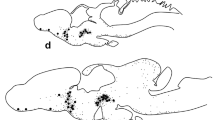Summary
Using immunocytochemistry, gastrin/CCK-like immunoreactivity is found in sensory nerve cells in the ectoderm of the mouth region of hydra and in nerve cells in the endoderm of all body regions of the sea anemone tealia. These results are corroborated by radioimmunoassay: One hydra contains at least 5 fmole and one tealia at least 2 nmole gastrin/CCK-like immunoreactivity. Reactivities towards gastrin and CCK antisera with different specificities suggest that the coelenterate gastrin/CCK-like peptide contains the C-terminal amino-acid sequence common to mammalian gastrin and CCK. In addition the radioimmunochemical data indicate that the coelenterate peptide also contains an amino-acid sequence that resembles the sequence 20–30 of porcine CCK-33, but that no other sequences of gastrin are present. Thus, it is probably more CCK-like than gastrin-like.
Similar content being viewed by others
References
Anastasi A, Erspamer V, Endean R (1968) Isolation and amino-acid sequence of caerulein, the active decapeptide of the skin of Hyla caerulea. Arch. Biochem Biophys 125:57–68
Baumgarten HG, Holstein AF, Owman C (1970) Auerbach's plexus of mammals and man: Electron-microscopic identification of three different types of neuronal processes in the myenteric ganglia of the large intestine from rhesus monkey, guinea pig and man. Z Zellforsch Mikrosk Anat 106:376–397
Coons AH, Leduc EH, Connoly JM (1955) Studies on antibody production. I. A method for the histochemical demonstration of specific antibody and its application to the study of the hyperimmune rabbit. J Exp Med 102:49–59
Creagh T, Skrabanek P, Cannon D, Balfe A, Powell D (1980) Phylogeny of substance P. Gen Comp Endocrinol 40:503–506
Dockray GJ (1979) Evolutionary relationships of the gut hormones. Fed Proc 38:2295–2301
Dockray GJ, Walsh JH (1975) Amino terminal gastrin fragment in serum of Zollinger-Ellison syndrome patients. Gastroenterology 69:222–230
Grimmelikhuizen CJP, Schaller HC (1979) Hydra as a model organism for the study of morphogenesis. Trends Biochem Sci 4:265–257
Grošelj P (1909) Untersuchungen über das Nervensystem der Aktinien. Arb Zool Inst Univ Wien 17:269–308
Hadži J (1909) Über das Nervensystem von Hydra. Arb Zool Inst Univ Wien 17:225–268
Johnson LR (1976) The trophic action of gastro-intestinal hormones. Gastroenterology 70:278–288
Kramer KJ, Speirs RD, Childs CN (1977) Immunochemical evidence for a gastrin-like peptide in insect neuroendocrine system. Gen Comp Endocrinol 32:423–426
Larsson LI, Rehfeld JF (1977) Evidence for a common evolutionary origin of gastrin and cholecystokinin. Nature 269:335–338
Oscarson J, Håkanson R, Liedberg G, Lundquist G, Sundler F, Thorell J (1979) Variated serumgastrin concentration: Tropic effects on the gastrointestinal tract of the rat. Acta Physiol Scand (Suppl): 475
Rehfeld JF (1978) Immunochemical studies on cholecystokinin. I. Development of sequence-specific radioimmunoassays for porcine triacontatriapeptide cholecystokinin. J Biol Chem 253:4016–4021
Rehfeld JF, Stadil F, Rubin B (1972) Production and evaluation of antibodies for the radioimmunoassay of gastrin. Scand J Clin Lab Invest 30:221–232
Straus E, Yalow RS (1978) Species specificity of cholecystokinin in gut and brain of several mammalian species. Proc Natl Acad Sci USA 75:486–489
Straus E, Yalow RS, Gainer H (1975) Molluscan gastrin: concentration and molecular forms. Science 190:687–689
Taban CH, Cathieni M (1979) Localisation of Substance P-like immunoreactivity in Hydra. Experientia 35:811–822
Westfall JA (1973a) Ultrastructural evidence for neuromuscular systems in coelenterates. Am Zool 13:237–246
Westfall JA (1973b) Ultrastructural evidence for a granule-containing sensory-motor-interneuron in Hydra littoralis. J Ultrastruct Res 42:268–282
Westfall JA, Kinnamon JC (1978) A second sensory-motor-interneuron with neurosecretory granules in Hydra. J Neurocytol 7:365–379
Author information
Authors and Affiliations
Rights and permissions
About this article
Cite this article
Grimmelikhuijzen, C.J.P., Sundler, F. & Rehfeld, J.F. Gastrin/CCK-like immunoreactivity in the nervous system of coelenterates. Histochemistry 69, 61–68 (1980). https://doi.org/10.1007/BF00508367
Received:
Issue Date:
DOI: https://doi.org/10.1007/BF00508367




